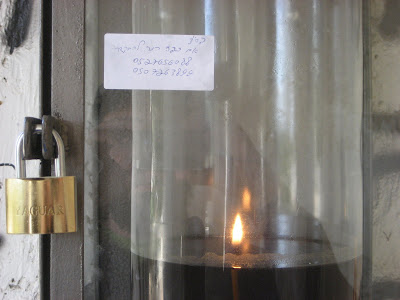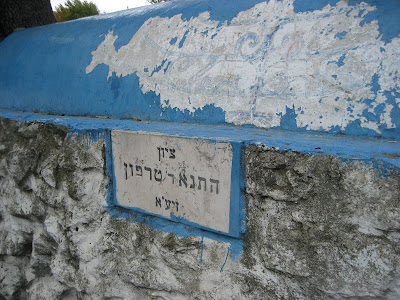


Ice cream and shakes are sold at a separate counter:

Some of the Pesach business are total scams. For example:


Anyone can make matzah pizza at home for a fraction of the price! Here's another:

If you look carefully at the word crossed out, you can see that this place used to be the proverbial glatt kosher bakery before they realized their error:

The chameitz law is ridiculous on a number of levels, but particularly because bagels are for sale in a very public place frequented this week by Jewish and non-Jewish tourists from around the world, just inside Jaffa Gate:

When I was a kid, I was under the impression that ice cream was categorically not kosher for Pesach, so it was shocking to see kosher-for-Pesach ice cream everywhere! And it's not your typical kosher-for-Pesach products that are imitations of the real thing (cf. pasta); the issue is simply that Americans put corn syrup in everything! Since Israel doesn't have the Iowa caucus, they don't have to.
Another difference between the US and Israel is the large number of products labeled "kasher l'Pesach l'ochlei kitniyot". Though I don't eat kitniyot during Pesach, this made it easier to eat at home during the days before Pesach (when the kitchen was already kashered), and just to make a point, I ate kitniyot on Erev Pesach after the time to stop eating chameitz. And after Pesach began, I went by ingredients for "l'ochlei kitniyot" products and ate them if they didn't contain actual kitniyot (I don't care if they were made on equipment that also processes kitniyot).
Some Americans who otherwise don't eat kitniyot during Pesach found themselves eating kitniyot this year in Israel, in part because Israel has much more of a kitniyot culture. I had the opposite experience this year. I don't eat kitniyot during Pesach, and didn't this year, and if anything, this year pushed me further away from ever eating kitniyot in the future. Pesach in my family (in the US) is very carnivorous, and I used to say "If I ever become fully vegetarian, I'll eat kitniyot." This year I live in a vegetarian apartment, and ate a mostly vegetarian diet during Pesach and didn't eat kitniyot, and I did just fine, so now I know it's possible. So now the goalposts are pushed even further back to "If I ever become vegan." Not likely any time soon.
For me, not eating kitniyot is a minhag that I uphold completely irrationally, even though I think it's silly, simply because I have a minhag. (There aren't many things that I do that for.) This means that I can't be swayed, either l'kula or l'chumra, by any teshuvot or rational arguments. If you claim that it doesn't make sense for X (peanuts, corn, wild rice, etc.) to be considered kitniyot, because it's biologically unrelated to grains/legumes or because it wasn't known in medieval Europe, I'm not convinced, because the whole kitniyot apparatus already doesn't make any sense, so what's one more layer of nonsense? On the other hand, I'm also not going to be swayed by the kitniyotization of quinoa, since I have eaten quinoa during Pesach for several years, and have never had a minhag not to. Sesame seeds are another example. One can make a logical argument for why sesame seeds aren't kitniyot, but as far as I'm concerned, kitniyot has nothing to do with logic. BUT I distinctly recall having kosher-for-Pesach sesame candies as a kid, and therefore, as far as I'm concerned, they're ok, regardless of whether the OU or the rabbanut has changed its mind since then. They're not my authority. So the other night, when I was at an ochlei kitniyot restaurant (!) and was the only kitniyot non-eater in the group, I ate the techina. Like I said, this approach is uncharacteristic for me.
Anyway, it's over now. Next year in a rebuilt Jerusalem!


























































